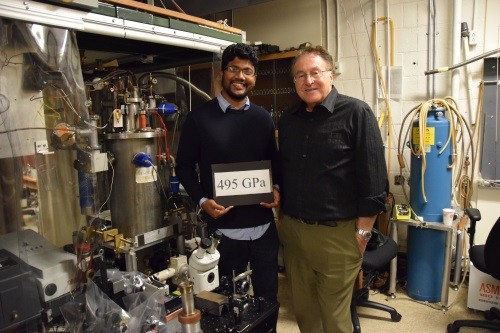Posts by: Michael Banks
Hawking’s PhD thesis, Einstein letter up for auction, first zero
By Michael Banks

Courtesy: University of Cambridge
The PhD thesis of the University of Cambridge physicist Stephen Hawking was made freely available to read this week by the university’s Library’s Office of Scholarly Communication.
Hawking completed his PhD – entitled “Properties of expanding universes” – in 1966 when he was 24 years old. To mark Open Access Week 2017, the 117-page tome was posted on the university’s Apollo open-access repository, which is already home to some 15,000 research articles and 2400 theses.
Yet within hours of Hawking’s opus being posted online, demand was so great that the site crashed. However, according to the university, it was still downloaded more than 60,000 times in the first 24 hours.
“By making my PhD thesis open access, I hope to inspire people around the world to look up at the stars and not down at their feet,” Hawking noted. “Anyone, anywhere in the world should have free, unhindered access to not just my research, but to research of every great and enquiring mind across the spectrum of human understanding.”
View all posts by this author | View this author's profile
Indian independence, Doppler effect on a train, contagious science
By Michael Banks
This week India celebrated 70 years of independence. So what better way to mark the occasion than a music video? Step forward 20 or so scientists from the Indian Space Research Organisation (ISRO), who dub themselves the Rocket Band. Over the space of 18 months, they worked feverishly to create a seven-minute music video entitled “I am an Indian”. Mostly shot on the coast of the Arabian Sea, the video features the researchers walking along the beach as well as an animation of the Indian flag being put on the surface on the Moon. “We have a lot of talent in ISRO, making rockets comes naturally to many of us while making music is tough but it is not rocket science,” aerospace engineer Shiju G Thomas told NDTV.
View all posts by this author | View this author's profile
Ancient eclipse art, asteroid finds early fame, unwitting face of graphene underwear
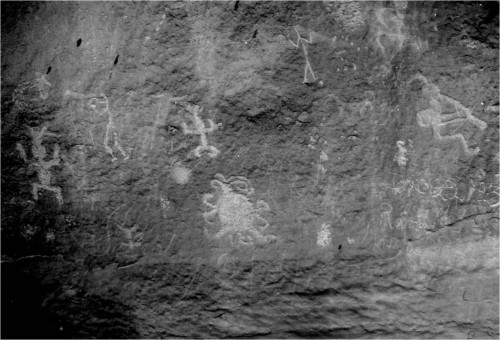
Ancient eclipse: a Chaco Canyon petroglyph (Courtesy: University of Colorado)
By Sarah Tesh, Matin Durrani and Michael Banks
The approaching total solar eclipse on 21 August is the subject of much interest and excitement — but the Earth has of course been in and out of the Moon’s shadow since it formed. While we have the technology to take spectacular photos of the corona framing the Moon, our ancestors were limited to much cruder means of recording such events. For example, the ancient petroglyph (a carving in rock) shown above may represent a total eclipse that occurred in 1097. The carving is on a free standing rock known Piedra del Sol in New Mexico’s Chaco Canyon. “I think it is quite possible that the Chacoan people may have congregated around Piedra del Sol at certain times of the year and were watching the sun move away from the summer solstice when the eclipse occurred,” says solar physicist J. McKim Malville from the University of Colorado, Boulder in the US, who focuses on archaeoastronomy. Other nearby carvings may be related to the 1054 supernova and the passing of Halley’s Comet in 1066. “The appearance of the spectacular supernova and comet may have alerted the residents of the canyon to pay attention to powerful and meaningful events in the sky,” says Malville. Hopefully our records of astronomical events will be as long lasting as those of the Chacoan people.
View all posts by this author | View this author's profile
Ravens at LIGO, stained-glass physics, fake space pics
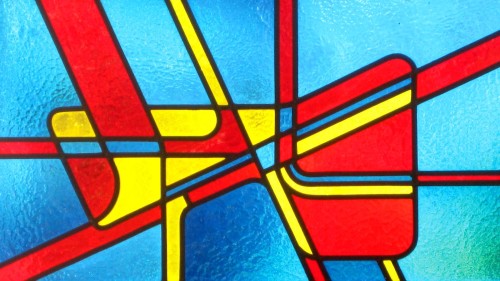
Grand designs: Los Alamos physicist Hubert van Hecke combines his hobby of stained-glass windows with physics. (Courtesy: Hubert van Hecke)
By Michael Banks and Sarah Tesh
Researchers working on the Laser Interferometer Gravitational-Wave Observatory might be answering some of the biggest questions in astrophysics, but last week they had a rather more down-to-Earth problem to solve. When spurious glitches were picked up by the detector characterization group at the LIGO detector based in Hanford, Washington, they went on an investigation to find the culprit. The team suspected that ravens were to blame as they had been seen causing mischief on tubes that vent nitrogen gas. These pipes are connected to the vacuum enclosure and any vibration could change the optical path length of light that is scattered from the test mass and reflected back. Upon closer inspection, LIGO researchers found peck marks that were “consistent with the size of a raven’s beak”. Not content with just watching the birds at play, the team even performed “simulated pecking” to see how this affected the machine’s performance. With the culprit now identified, you will be pleased to hear that the lines are set to be insulated to fend off the birds. “I guess we can’t blame [the ravens] for desiring ice on a hot desert afternoon,” writes Robert Schofield in a LIGO logbook post.
View all posts by this author | View this author's profile
Physics World’s latest special report on China is out now
By Michael Banks
The pace of change in China can be bewildering – and science is no exception. With every year that goes by, the country publishes more papers, spends more cash on research and opens up yet more world-class facilities.
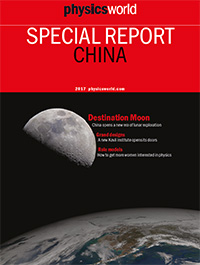 This is the third Physics World special report on physics in China – following publications last year and in 2011.
This is the third Physics World special report on physics in China – following publications last year and in 2011.
Most of this year’s report was based on an action-packed schedule of visits and interviews earlier this year at institutes and labs in Shanghai and Beijing.
Speaking to researchers during my travels, it became clear that China is reaping particular benefits from its 1000 Talents programme, which seeks to persuade top Chinese researchers who have spent time abroad to return home. Such scientists are bringing huge experience back and using it to put China at the forefront of many fields of research.
China is also showing a growing appetite to attract foreign scientists who have not worked there before. Getting overseas researchers to move to China is not always easy, so one solution has been for China to encourage Western institutions to branch out into the country. The Kavli Foundation, for example, has just opened a new Kavli Institute for Theoretical Sciences in Beijing, which aims to have about a third of its faculty from outside China.
View all posts by this author | View this author's profile
Sculpture inspired by neutrino lab unveiled

Putting it all together. (Courtesy: Garrett Elliott)
By Michael Banks
A sculpture inspired by the geometry of the neutrino detector at the Sudbury Neutrino Observatory (SNO) has been unveiled at Queen’s University in Kingston, Canada.
SNO, which operated from 1999 to 2006, was located 2.1 km underground in Sudbury, Ontario, and designed to detect neutrinos from the Sun through their interactions with a large tank of heavy water.
View all posts by this author | View this author's profile
The STAR of the show

Grand designs. (courtesy: Applied Fusion Systems)
By Michael Banks
You may remember in 2014 when we reported that entrepreneur Richard Dinan – a former star of the UK reality-TV programme Made in Chelsea – was venturing into fusion energy.
He founded the firm Applied Fusion Systems with the aim of building a prototype fusion reactor. The 30 year old, who doesn’t have a university degree, claims to have taught himself tokamak design and employs a small team of scientists who are working on a design.
Well, the firm has now released its first blueprint for a spherical fusion tokamak and is seeking £200m in investment to build not one, but two of the machines.
View all posts by this author | View this author's profile
Building bridges with the west
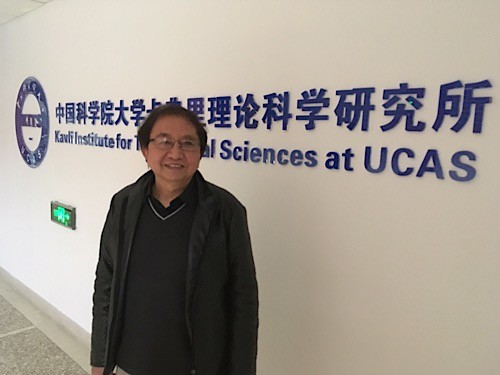
Physicist Fuchun Zhang, director of the Kavli Institute of Theoretical Sciences.
By Michael Banks in Beijing, China
It’s my final day in Beijing and keeping up with the daily weather reports, it is still raining. But that is better than the snow that was forecast only a couple of days ago.
My time in Beijing has been short, but packed full of interesting discussions with researchers.
Yesterday I headed to the Beijing Institute for Nanoenergy and Nanosystems. Today, I visited the theoretical condensed-matter physicist Fuchun Zhang, who is director of the Kavli Institute of Theoretical Sciences (KITS).
View all posts by this author | View this author's profile
A blue energy dream
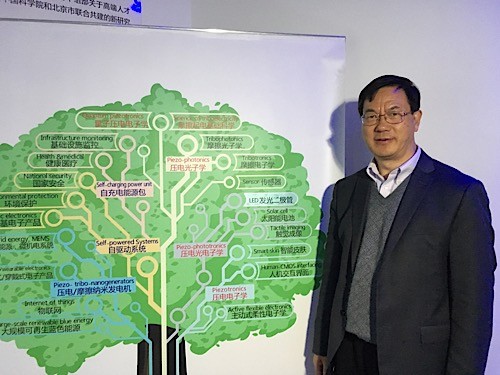
Zhong Lin Wang, director of the Beijing Institute of Nanoeergy and Nanosystems.
By Michael Banks in Beijing, China
I was told that it wouldn’t rain much in Beijing, a city known for its dry air – and pollution.
But since I arrived here last night courtesy of the bullet train, all I have seen is drizzle. The wet weather also made it a challenge during rush hour, but I finally made it to the Beijing Institute for Nanoenergy and Nanosystems (BINN).
I met with BINN’s director, Zhong Lin Wang, who has been in the US for more than 39 years, most of which has been spent at the Georgia Institute of Technology. While he is still affiliated to Georgia Tech, he came back to China in 2012 to establish BINN.
View all posts by this author | View this author's profile
